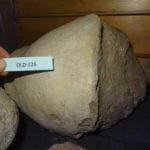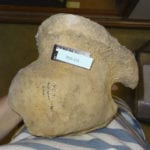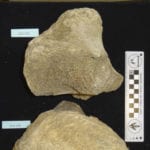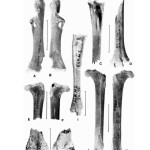 |
OLD-226 |
12500 |
|
|
FEM-f |
|
114 - Natural History Museum UK |
|
|
|
-- |
OLD-226; distal femur fragment |
|
|
|
Unknown |
|
Mammalia |
Proboscidea |
Tethytheria |
Behemota |
Elephantoidea |
Elephantidae |
|
|
|
|
|
|
No |
 |
OLD-233 |
12508 |
18 - VEK |
|
FEM-f |
|
114 - Natural History Museum UK |
|
|
|
-- |
OLD-233; femoral head fragment; "VEK Site antiquus s?" |
|
|
|
Unknown |
|
Mammalia |
Proboscidea |
Tethytheria |
Behemota |
Elephantoidea |
Elephantidae |
|
|
|
|
|
|
No |
 |
OLD-234 |
12509 |
|
|
FEM-f |
|
114 - Natural History Museum UK |
|
|
|
-- |
OLD-234; proximal femur fragment; might be same individual as OLD-235 |
|
|
|
Unknown |
|
Mammalia |
Proboscidea |
Tethytheria |
Behemota |
Elephantoidea |
Elephantidae |
|
|
|
|
|
|
No |
 |
OLD 15473 |
10158 |
6 - FLK NN |
|
L-FEM |
|
|
I |
|
Layer 3 |
Brodkorb P., Mourer-Chauviré, C. 1984. Fossil owls from early man sites of Olduvai Gorge, Tanzania. Ostrich; Journal of African Ornithology 55:17-27. |
PARATYPE. OLD 15364 and OLD 15473 are "proximal and distal parts of left femur" (Brodkorb and Mourer-Chauvire, 1984:17). "Paratypes: The following specimens are from layer 3 of locality FLK NNI and can be attributed to the same individual as the holotype: 15740, premaxillae; 3301, lower part of right coracoid. 15364 and 15473, proximal and distal parts of left femur; 16377, distal part of right femur; 15701, distal part of left tibiotarsus; 15776, left fibula; 16262, proximal part of right tarsometatarsus; 15730, distal part of left tarsometatarsus; 15942, 15946, 16050, 16171, 16174, 16176 to 16180, pedal phalanges. Place of conservation of the material: The fossils are currently on deposit at the University of Florida, Department of Zoology, and will later be returned to Tanzania" (Brodkorb and Mourer-Chauvire, 1984:17, 19). Image notes: (Scale = 2 cm) A-B: Left coracoid, holotype, OLD 15802, FLK NNI, layer 3, A anterior face, B posterior face. C: Right tarsometatarsus, proximal part, paratype, OLD 16262, FLK NNI, scree, anterior face. D: Left tarsometatarsus, distal part, paratype, OLD 15730, FLK NNI, layer 3, anterior face. E-F: Left femur, proximal half, paratype, OLD 15364, FLK NNI, layer 2+3, E anterior face, F Posterior face. G-H: Left femur, distal part, paratype, OLD 15473, FLK NNI, layer 3, G anterior face, H posterior face. I: Left tarsometatarsus, almost complete, OLD 11574, FLK NI, layer 1, anterior face. J-K: Left femur, lacking the distal part, OLD 11586, FLK NI, layer 2, J anterior face, K posterior face. |
|
|
|
Unknown |
|
Aves |
Strigiformes |
|
|
|
Strigidae |
|
|
Bubo |
leakeyae |
|
|
No |
 |
OLD 16377 |
10160 |
6 - FLK NN |
|
R-FEM-f |
|
|
I |
|
Layer 3 scree |
Brodkorb P., Mourer-Chauviré, C. 1984. Fossil owls from early man sites of Olduvai Gorge, Tanzania. Ostrich; Journal of African Ornithology 55:17-27. |
PARATYPE. Distal portion of right femur. "Paratypes: The following specimens are from layer 3 of locality FLK NNI and can be attributed to the same individual as the holotype: 15740, premaxillae; 3301, lower part of right coracoid. 15364 and 15473, proximal and distal parts of left femur; 16377, distal part of right femur; 15701, distal part of left tibiotarsus; 15776, left fibula; 16262, proximal part of right tarsometatarsus; 15730, distal part of left tarsometatarsus; 15942, 15946, 16050, 16171, 16174, 16176 to 16180, pedal phalanges. Place of conservation of the material: The fossils are currently on deposit at the University of Florida, Department of Zoology, and will later be returned to Tanzania" (Brodkorb and Mourer-Chauvire, 1984:17, 19). Image notes: (Scale = 2 cm) A-B: Left coracoid, holotype, OLD 15802, FLK NNI, layer 3, A anterior face, B posterior face. C: Right tarsometatarsus, proximal part, paratype, OLD 16262, FLK NNI, scree, anterior face. D: Left tarsometatarsus, distal part, paratype, OLD 15730, FLK NNI, layer 3, anterior face. E-F: Left femur, proximal half, paratype, OLD 15364, FLK NNI, layer 2+3, E anterior face, F Posterior face. G-H: Left femur, distal part, paratype, OLD 15473, FLK NNI, layer 3, G anterior face, H posterior face. I: Left tarsometatarsus, almost complete, OLD 11574, FLK NI, layer 1, anterior face. J-K: Left femur, lacking the distal part, OLD 11586, FLK NI, layer 2, J anterior face, K posterior face. |
|
|
|
Unknown |
|
Aves |
Strigiformes |
|
|
|
Strigidae |
|
|
Bubo |
leakeyae |
|
|
No |
|
OVPP Bubo 3 |
10185 |
7 - FLK North |
|
COR-f
, HUM-f
, RAD-f
, ULNA-f
, CARMET-f
, FEM-f
, TBT
, CUNE
, PHX |
|
|
I |
|
|
Brodkorb P., Mourer-Chauviré, C. 1984. Fossil owls from early man sites of Olduvai Gorge, Tanzania. Ostrich; Journal of African Ornithology 55:17-27. |
Coracoid, 2 upper and 2 lower parts; humerus, 3 distal parts; radius, 2 proximal parts; ulna, 1 distal part; carpometacarpus, 3 proximal parts; femur, 4 proximal parts and 1 distal; tibiotarsus, 3 distal parts; tarsometatarsus, 1 almost complete, 1 proximal and 1 distal parts; 1 ulnare (listed in elements as cuneiform); 20 pedal phalanges. Authors do not specify specimen numbers and refer to these specimens as "referred material". Place of conservation of the material: The fossils are currently on deposit at the University of Florida, Department of Zoology, and will later be returned to Tanzania" (Brodkorb and Mourer-Chauvire, 1984:17, 19). |
|
|
|
Unknown |
|
Aves |
Strigiformes |
|
|
|
Strigidae |
|
|
Bubo |
leakeyae |
|
|
No |




